Alfred Silvester – the Fakir of Oolu and his Family of Magic
Chapter Twelve – Alfred William Silvester in Australia
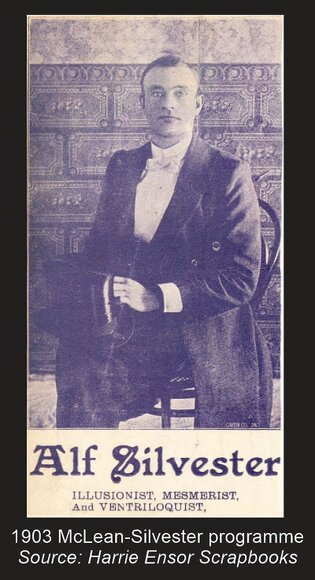
“The Astras and Silvester show at the Town Hall constituted one of the most remarkable demonstrations of 'thought reading' ever seen in Melbourne. The 'stunt' has, of course, been done here before, but never have the results been so completely mystifying. The large audience on the opening night was keenly interested, and showed unmistakably its appreciation of a first-rate entertainment. In every case Astra's replies were vouched for by the audience as correct, and in some cases Astra's knowledge seemed almost uncanny.
- Graphic of Australia October 24, 1918
- Graphic of Australia October 24, 1918
With the exception of a return tour to New Zealand in 1919, Alf Silvester’s 1915 arrival in Australia marked the start of an epic adventure in this country lasting more than two decades; not one in which he became world-famous or made his fortune, but through which he can be counted among the great Australian Outback theatrical touring troupes. The last of the Silvester magicians, he tackled life with a gritty determination that encompassed every available facet of variety performance; skills that have been handed down to the present generation.
Alfred was already forty years old. He had progressed from being an occasional regional performer to learning the vicissitudes of the touring life and, by the time he came to Australia, was a fully-fledged professional with an extensive repertoire. The first World War was raging, but he was too old to consider volunteering, and essentially the war remained ‘over there’. Two referenda to introduce conscription in Australia were held in 1916 and 1917 but both were defeated. Had he remained in New Zealand, Alfred may have found himself conscripted when the Military Service Act was passed in August 1916.
Along with Rhoda Rainton and her child, Alf arrived in Australia after June 1915. Their first appearance was in Sydney on August 11, where they were mentioned briefly as ‘an illusionist turn’ at the Sydney Stadium. It is possible that the Silbinis’ reason for coming to Australia was through a booking by the prominent Tivoli circuit of theatres since, from August 24, they moved to Brisbane and were featured as mind readers at the Tivoli theatre alongside a magician billed as ‘Mysto, Coin Manipulator.’ This was the young Arthur Buckley, who would go on to make a big name for himself overseas.
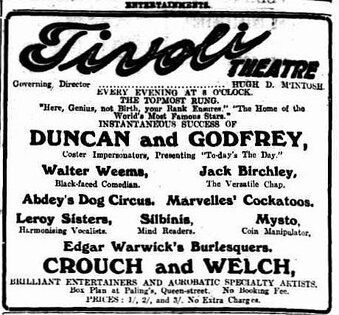
TIVOLI CLAIMS
The season at the Tivoli lasted not much more than a week; both Silbinis and ‘Sylvestor’ appeared in advertisements to September 3, after which no more is seen, and no evidence can be found to prove that they later played the Tivoli in any of the other circuit theatres in Sydney, Melbourne, or Adelaide. This, however, would not prevent Alfred from taking out large advertisements in 1916 with a ‘Managerial Notice” that “the companies which in the past have visited [Canowindra] and billed themselves as of the National and Tivoli Theatres tried to deceive the people, and that we will forfeit £100 to any charitable institution if any person or persons can prove that the Silbinis are not of the Tivoli.” The Robertson Advocate of July 28, 1916, said they had found “an idle date prior to opening a lengthy season, commencing on August 12th at the Melbourne Tivoli. Silbini concluded a remarkable season at the Sydney Tivoli on July 14th, previous to which they toured the whole of New Zealand under the Tivoli management.”
The claims were nothing more than hokum. The Silbinis had not toured New Zealand under Tivoli management, they were not headed for the Melbourne Tivoli (on August 19 they were at Picton in New South Wales billed as ‘direct from the Tivoli coy. City’) and there had been no season at the Sydney Tivoli – in fact the magician appearing at the Tivoli in that period was none other than the great Horace Goldin. At best, Alf was milking his short time at the Brisbane Tivoli for all it was worth; and by February 1917 he was advertising his company under the name ‘The Tivoli Touring Wonder Show’, implying subtly that this was a show connected to the Rickards’ Tivoli circuit.
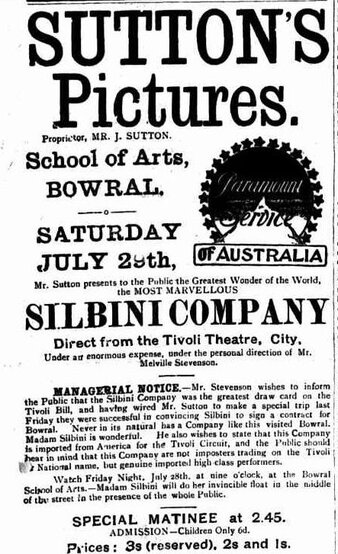
“The entertainment”, said the Picton Post, “can only be described as wonderful … there was not a dull moment, and everyone was delighted … two outstanding features were the disappearing canary and cage, which vanished mysteriously under the very eyes of the audience, and the equally inexplicable disappearance and reappearance of a glass of water, which retained its contents throughout … the second-sight séance of Madame Silbini, in which she correctly described all manner of articles held up in various parts of the hall, was equally mystifying; while Thelma, the little ‘Dancing Sunbeam’ [we must assume this was Rhoda’s girl] was very fine in her plantation song and dance. Miss Rhoda Silbini’s vocal number, ‘If the World were Ruled by Girls’, her male impersonation in ‘The Black Sheep of the Family,’ and her manipulation of the glassophones stamped her as a very versatile artist …. The ventriloquial talents of Professor Silbini were displayed through ‘Tommy the Terror’ and proved very amusing. On Monday afternoon great interest was evinced in Professor Silbini’s feat of hypnotising a young man on the verandah of Mr. Carey’s shop, and the awakening of the subject several hours later, none the worse for his experience.”
Clearly, Silvester was not one to remain in the largest cities, hoping for an engagement. By September the troupe had moved out to Western New South Wales, at Cowra, Canowindra, Orange, Wellington, under canvas and billed as the Tivoli Moving Theatre. Tumut, Gundagai and Cootamundra welcomed the travelling show. Silvester was noted as performing the Masks and Faces routine, and several illusions including the Palanquin production of a woman, and ‘The Monk’s Escape’ in which a person vanished instantly at the firing of a pistol.
Of interest is a letter, held at the Museum of Performing Arts (Perth), from the manager of Melbourne’s Star Theatre – “Have you any objection using name Silvester instead of Silbini. Former name well remembered here. Previous generation means good advertising stuff.” Alfred, at least for now, was not ready to fall back on his well-remembered relatives.
The start of 1917 saw the troupe, now the ‘Tivoli Touring Company’, move from the Yass and Braidwood region as far up as the Hunter Valley and the northern border of New South Wales. Queenie Cooper seems to have joined up at Braidwood and was featured in the Sleeping Beauty role, while a “Gwen” Rainton was regularly promoted as a female impersonator; but there is no evidence to suggest that Gwen was anyone other than Rhoda Rainton, doing double duty with her second-sight routine. Another performer was introduced during the Grafton season in April – she was advertised as ‘Lola Maiden, the American monologue artist’ which was showman’s guff; Lola’s identity will be revealed later. Various other incidental performers appeared on the bill for a short stay, and by June the Tivoli company had crossed into Queensland after a successful run of shows, landing at Toowoomba in July.
Notably, ‘Mr Jay Bryant’ had been mentioned amongst the cast in May. Suddenly, in August 1917, all advertising for the Silbini show stopped. When the show resumed in November, the troupe was back in Northern New South Wales, and Lola Maiden had become ‘Lola Monk’, taking over the Second-sight routine. The company had split, and Rhoda Rainton and John Bryant had gone off together, taking with them the title ‘Tivoli Touring Theatre’, the names ‘Rhoda the Mysterious’ and ‘Gwen Rainton’, Miss Queenie Cooper (‘the little red-headed bundle of fun’) and the second-sight routine. Most confusingly, especially for the belaboured history researcher, they advertised ‘Miss Silbini’ as a member of their troupe as late as 1920. They would acquire, at some stage, an apparatus for the aerial suspension illusion, and John Bryant, as ‘Mr. Melbin’ performed magic amongst his other talents. Bryant and Rainton worked together as a duo for many years to come and would eventually marry.
Alf Silvester was now essentially taking on the major load of his own show, with Lola Monk assisting, and some short-term musical and ‘statuary posing’ acts; his company was now the ‘Tivoli Entertainers.’ His popularity in the Grafton region remained strong, and performances continued into 1918 when, in January, the Silbinis moved down to Sydney and started appearing with Harry Clay’s Vaudeville, a circuit of suburban theatres with a strong leaning towards variety acts; Clay’s companies also ventured as far west as Lithgow.
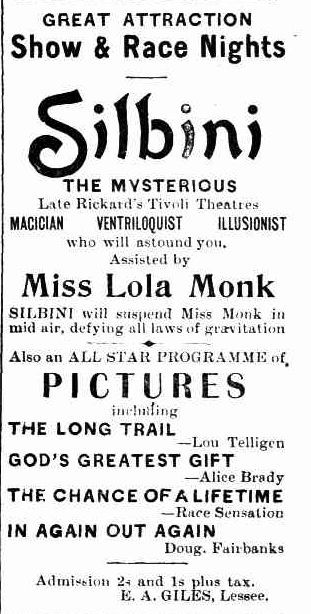
By February 1918 the troupe had once again changed its name and become the “20th Century Entertainers” or on occasion the Tiv-Olio Entertainers. There were some notable evolutions when they appeared in Tamworth. Although magic was still the mainstay of the show, Alfred and Lola’s mind-reading act was beginning to stray into somewhat grey areas of implied psychic powers (“she tells you what you are thinking about, what you want to know … all about your missing friends, all about your absent ones…”). There was a fine line to be walked here, as dabbling in people’s private affairs could lead to upset and complaints, and the law looked severely upon anyone who appeared to be making money from fortune-telling. However, they seem to have stayed away from any major controversy; the act was still basically the Second Sight routine, with a Sealed Envelope question-answering.
The other new attraction at Tamworth was that Alf had acquired several exotic animals, which would become a feature of his show for years to come. Cara was a panther (later photographs however show a spotted cat more appropriately termed a leopard), and Leo and Daisy were lions. They were all tame, and would do little more than lie onstage during the show, or parade down the street attracting attention for publicity purposes. Daisy was at times pressed into service in a challenge tug-of-war between the animal and a local resident. It could also be said that the lioness was the last “Daisy Silvester” in the family!
The troupe, though ever-changing, grew in size during 1918 as they toured to many locations in New South Wales, including such acts as Miss De Alroy (musician), the Hardy Sisters (singers, dancers and jugglers, ‘introducing their real live bears’), Harry Jones the eccentric comedian, and Queenie O’Brien on the piano.
SILBINI BECOMES SILVESTER - WITH ASTRAS THE MIND READER
Changes were afoot, and with Alf’s predilection for mysterious stage names, and his regular changes of assistant, there is some difficulty in identifying his mind-reading partner. Silbini and ‘Lola Monk’ were seen in Newcastle on September 26. Alfred then moved out of New South Wales and down to Melbourne, Victoria. On October 14, Alf dumped his former stage name, Silbini, and became Silvester once more (and frequently, ‘Sylvester’). He would now deliberately use his family history with the Fakir of Oolu, and his father Alfred2, as publicity material.
Opening with a week-long show at the Melbourne Town Hall he advertised his partner as “Astras, the mystic mind reader”. Was Astras a new partner, or his existing performer, Lola Monk, under a new name?
Considering Alf’s love of misleading publicity stories, this information from the ‘Westralian Worker’ 1920 (3) seems at first glance to be just another puff piece for the press:
“Sylvester, the master magician at the Shaftesbury, represents the third generation of conjurers and illusionists. His grandfather, Dr. Sylvester [sic] the ‘Fakir of Oolu’ was here in 1865 [incorrect, Silvester first arrived in Australia in 1874]. His father, Professor Sylvester, was here in the 80s. With all their tricks in his repertoire, no wonder Sylvester is an amazing exponent of the Black Art. Astras, the psychic marvel, now at the Shaftesbury, is a pleasant, refined little lady with no pretence of ‘staginess.’ Her parents are Spanish, and are in business in Sydney today. They strongly disapprove of her stage career. She was born in the Philippines, and as a child was able to anticipate her mother’s wishes to such an extent as to be regarded as a freak. Developing this talent, while still a youngster she joined a theatrical enterprise and toured Mexico. Since then she has never looked back. … One of Sylvester’s most treasured possessions is a magic wand, presented to his grandfather, Dr. Sylvester the Fakir of Oolu, after the Dr. had ‘appeared’ by command before the late Queen Victoria.”
Astras was, in fact, the same ‘Lola Maiden’ or ‘Lola Monk’ who had been working with Silvester since 1917. Her real name (4) was Maria de Los Dolores Isabel MacFarlane, daughter of Mr G. MacFarlane of Turramurra, Sydney. Given her name, it seems likely that there was a family connection back to the Philippines and that the name ‘Lola’ was derived from Dolores.
She married (April 19, 1911) Mr. Gordon Maiden, a well-known theatrical advance agent who would head up the tours of Lloyd’s Circus, Barton and Wharton’s Follies, and wire-walker Con Colleano, and that of Alfred Silvester. Given his circus connections, it is possible that Maiden helped Silvester to obtain his feature panther and lions.
The Herald, October 21: “An unusual season was commenced at the Town Hall on Saturday when Astras, the Mystic, gave a thought-reading seance. Numbers of articles of every description were accurately described by her while she sat blindfolded on the stage. Not even the smallest details were missing in regard to the articles presented by the audience … Silvester, the Magician, mystified his audience with his demonstrations and illusions. In one case he suspended a lady horizontally in mid-air from a stage unsupported in any way. He showed the escape of a girl through the air from a cabinet, and her almost immediate reappearance at the other end of the hall. In view of the audience he grew a variety of beards and moustaches on his face. He gave an exhibition of rapid paper folding into a multiplicity of shapes, and without any covers to hide his work made birds and birdcages disappear before the eyes of his audience, turned handkerchiefs into eggs, made a full glass of water disappear apparently into thin air and finally reproduced it from the body of a boy in the audience. Mademoiselle Irma Caron rendered artistically songs from Puccini and Gounod; Tito Matter, Leon Caron and Gustave Kerker appearing effectively in character costumes, and being recalled repeatedly. Stewart and Lorraine, two clever musicians, rendered a variety of work on unusual musical instruments. As the Town Hall is otherwise engaged the season is limited to a further four nights.”
It was a successful start in Melbourne for Alf, and over the next two years he reached the peak of his theatrical life, with constant work in the best theatres of Australia and New Zealand.
SILVESTER JOINS THE FULLER CIRCUIT
The theatrical empire built by Sir Benjamin and John Fuller spanned some twenty theatres including the National/Adelphi/Majestic in Sydney, the Princess/Gaiety/Palace in Melbourne. Second only to the Tivoli circuit, Fuller’s was far more nurturing of such local talent as Queenie Paul, Jim Gerald, George Wallace and those legendary larrikins, Stiffy and Mo (Nat Phillips and Roy Rene). They also extended their reach by touring full companies to New Zealand.
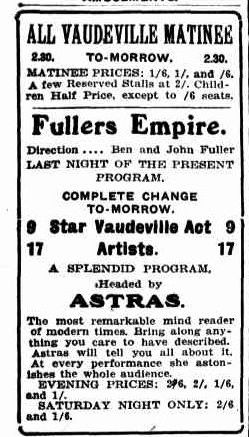

Silvester and Astras began with Fuller’s in November 1918, featuring both the Psychic routine, Alfred’s magic and the Entranced Lady illusion. They were not only part of the show, they generally received top billing in newspaper advertising. On December 19, the legendary Dame Nellie Melba gave a concert at the Melbourne Town Hall to welcome home the returning ANZAC soldiers, a triumphant afternoon in which Silvester and Astras performed as support artistes.
From the New Bijou Theatre in Bourke Street, the pair moved to Adelaide’s Majestic and the Brisbane Empire in January through February 1919 (“Astras again held the audience enthralled by her startling ability as a mind reader … [Silvester] had a happy, entertaining way about him that made him a great favourite; in fact he was even more popular than last week.”) (5), the Rockhampton and Townsville ‘Olympia’ theatres, and then back down into New South Wales via the Victoria (Newcastle) in March. Mid-May saw them open in Sydney at Fuller’s Theatre in Castlereagh Street where they headed the variety (vaudeville) half of the show after the famous duo of Nat Phillips and Roy Rene presented their rollicking “The Waiters” comedy in the first half. They were still there at the end of May when Stiffy and Mo turned into “The Plumbers”. Newcastle received a return visit in June, and then the duo packed their bags. Alfred was about to return home to New Zealand.
NEW ZEALAND 1919 - 1920
Silvester and Astras, still under the direction of the Fuller circuit, opened at the Princess Theatre, Dunedin New Zealand, on July 21, 1919. They were promoted as just having come ‘from a triumphal tour of the East’ and Astras had her full-grown panther, Cara, with her on the stage; and later they were joined by a lion cub. The press seemed not to notice that the star attraction, Alfred, had spent the greater part of his life in New Zealand. There is no indication that he re-visited Evangeline Trow, to whom he was still formally married (Chapter 11).
From the Dunedin Evening Star:- “The worker of the most arresting wonders was Astras, a young and attractive lady who proved up to the hilt her possession of marvellous psychic powers, and who read the thoughts of people in the audience with the ease of a wireless operator taking a message under perfect conditions … there was an ease and freshness about it that was unusual … Astras sits calmly (blindfolded, of course) holding by a chain her ‘familiar,’ in the form of a beautiful, lithe, restless panther, and answers the questions put to her by her partner promptly, smilingly, and no apparent effort. And the replies were startlingly correct … the other wonder- worker was Silvester whose skill in sleight-of-hand tricks is marvellously developed, enabling him to make a glass of water, a canary cage and other things equally awkward to dispose of quickly disappear into thin air. But it was his ‘aerial tableaux’ that made the audience gasp with astonishment. A lady (who afterwards proved to the be lady of the panther, the wonderful Astras) was utilised in this act. She stood upon a stool, her forearms resting on rods. After Silvester had ‘mesmerised’ her, the stool and one of the supporting rods were removed. It was impossible for her to find sufficient support in the remaining rod, but with nothing else – nothing, at any rate, that was visible to the naked eye … the lady, thus suspended in mid-air, was … finally raised to a lying position, still unsupported … Both theses ‘wonder’ acts are genuinely good and worth seeing.”
Alf was performing much the same magic as ‘Silbini’ had done previously – the Entranced Lady, small magic, ventriloquism, and the ‘Masks and Faces’ routine. The duo extended their stay in Dunedin twice due to packed houses, before moving to Christchurch Opera House in mid-August, Wellington Opera House in September, then Auckland Opera House through to October 20.
After almost a year, they had finally played out the Fuller circuit, but their great success in New Zealand gave encouragement to continue on their own account, and by early November they were at Kaipara in the North Island. Touring the Waikato region, they covered the King Country and then Manawatu before closing out the year at the Palace Theatre, Wanganui, on December 27.
Fuller’s was not yet done with Silvester and Astras. In 1920 they returned to headline at Fuller’s Opera House at Christchurch (from January 19), Dunedin Princess Theatre in early February, concluding the tour at Wellington’s His Majesty’s Theatre. It had been a busy and highly-praised season, and by the end of March Silvester, Astras, and the big cats were back in Sydney playing at the Alhambra Theatre in the Haymarket. They were featured as the guest performers in a new Australian Pantomime, “The Wattle Bird”, and now a monkey was added to the list of animals filling up the stage. There followed a May/June season with Harry Clay’s suburban circuit. A noticeable change in theatre was making itself felt; moving pictures were encroaching on the territory formerly held by live variety theatre.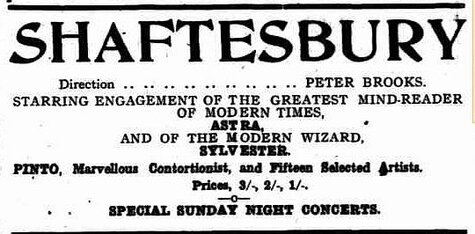

At the end of July they were booked to travel across to Western Australia where Alf had spent his early childhood. They were at the Shaftesbury Theatre (of which, in later life, Alf would be director of the ‘New Hollywood Theatre’). Perth decided that ‘Astras’ should be called ‘Astra’, and in this season Alf probably revelled in achieving a level of success that his father was never able to reach in the western state – a sustained and popular season. On August 12, the house was full, and both Astras’ and Silvester’s acts were reviewed as “undoubtedly the chief feature of the bill.” By September the press declared that the Shaftesbury had been drawing record houses.
Sunday Times, September 19, 1920 – “A well-known horse auctioneer, a consistent patron of vaudeville, was sampling the puzzling mind-reading act of Astras. He had never seen the lady perform before, having been away.
With his wife beside him he viewed the voluptuous-figured Venus telling the audience what was in their minds. The more he gazed upon her buxom beauty and radiant smile the more he wanted to go behind the stage.
Professor Sylvester came along towards him and told another man that he was thinking about a racehorse, and another that he was brain-waving Hampton Plains. Before Sylvester could reach him the auctioneer hurried outside.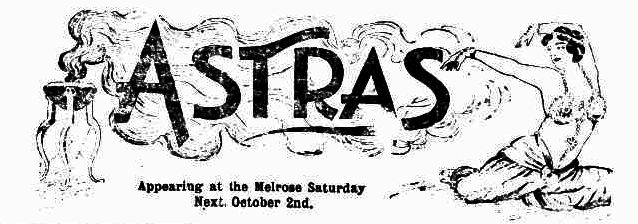
“What did you go out for during the Astras act?” asked a friend.
“I was thinking of her buxomness,” he assured, “and I had the wife with me.”
With his wife beside him he viewed the voluptuous-figured Venus telling the audience what was in their minds. The more he gazed upon her buxom beauty and radiant smile the more he wanted to go behind the stage.
Professor Sylvester came along towards him and told another man that he was thinking about a racehorse, and another that he was brain-waving Hampton Plains. Before Sylvester could reach him the auctioneer hurried outside.

“What did you go out for during the Astras act?” asked a friend.
“I was thinking of her buxomness,” he assured, “and I had the wife with me.”
After a brief appearance at the Melrose Theatre, the duo left Perth in October, after two highly successful months.
ZODIAC ARRIVES - ASTRAS BECOMES REMONA
By November 1920 a noticeable change was being made to the Second-Sight act. At Lithgow on November 29, Silvester joined with Will Kenny’s Costume Comedy Company at the Colosseum. On the same bill was Daisy Silvester, the sister of Alfred and a former theatrical dancer of note (see Chapter 9) who was now married to Will Kenny.
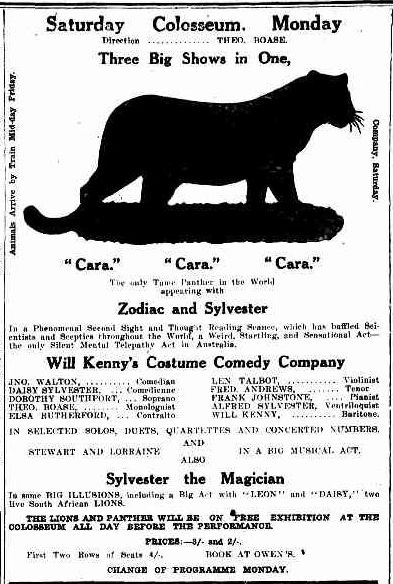
Notably, however, it was not ‘Astras’ billed as the psychic performer, but ‘Zodiac’, though aside from the stage name the description of the act was unchanged. There is a cross-over period from December 1920 to June 1921, in which Astras is still mentioned on occasion, but Zodiac comes gradually to the fore, as though Alf was training up a new partner in the skilled mind-reading act. Both names are seen during a December season in Brisbane, Toowoomba and Ipswich.
There does not appear to have been any falling-out, as Silvester continued to work with Gordon Maiden as advance agent, but Lola Maiden (Astras) was moving towards setting herself up as a solo performer. Up until March 1921 she was billed a couple of times under her old name, ‘Lola Monk’, and by June 22 at Taree (possibly after a short trip to the United States) she launched into a new career under the banner of the ‘Astras Amusu Coy.’ amongst which was featured Mr. Walter ‘Hats’ McKay, an American Blackface comedian and multi-instrumentalist.
Astras now had a new line of mental abilities. Billed as ‘The Woman with the Quintuple Brain,’ her advertising read “Performing six different feats simultaneously. She tells you all you want to know, reads, writes upside down and backwards, adds up three columns of figures at the same time. Truly the most Weird Girl that has ever visited this country.” Those feats are recognisable vaudeville talents, relying on a degree of magician’s technique, but still requiring much skill and practice.
The name Astras now faded away, and Lola Maiden took the stage name ‘Remona’. She joined the Fuller circuit as a headline act alongside Hats McKay with his Hawaiian Steel Guitar. She made a return visit to the Shaftesbury in Perth, May 1922 (7) and toured Adelaide and Sydney before departing in October 1922, along with McKay, for a trip to Hawaii and other islands, returning in 1922 to the Fuller and Clay circuits, working constantly. In November 1925 she was in Honolulu and was stricken with appendicitis which kept her from performing for several months. (6) but she was seen again at the Toowoomba Empire (with Hats McKay) as late as August 1929.
Gordon Maiden moved to divorce his wife on the grounds of desertion and the marriage was dissolved in October 1924, and Lola married Walter McKay on December 11, 1925. Gordon Maiden would die in August 1933 of a sudden heart attack while working for Barton’s Follies.
Alf Silvester, then, was working with a new partner, Zodiac the Marvel. Who was she, and how did she come to take over the mind-reading partnership? The answer is one of the most surprising twists in the Silvester story, and will be discovered in Chapter Thirteen.
REFERENCES FOR CHAPTER TWELVE
(1) Picton Post, August 9, 1916 p.6
(2) Museum of Performing Arts, Perth, record IH-70
https://www.mopa.ptt.wa.gov.au/search/silvester
https://www.mopa.ptt.wa.gov.au/search/silvester
(3) Westralian Worker, Perth W.A., August 13 1920 p.7
(4) Daily Telegraph, September 25 1924 p. 10
(5) Telegraph, Brisbane, February 3, 1919
(6) Will Alma’s Magic Circle Mirror, February 1975.